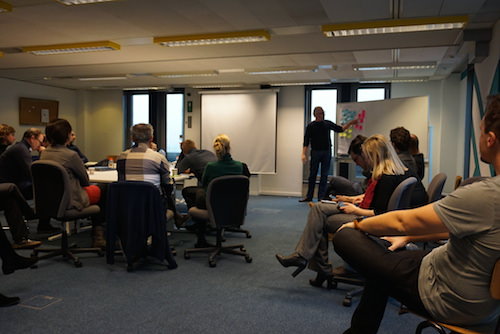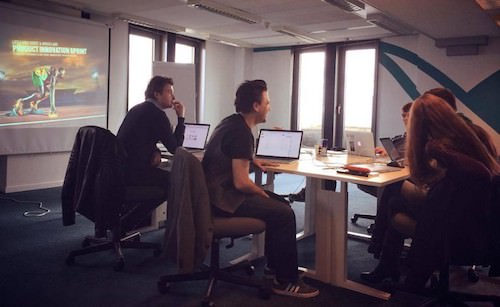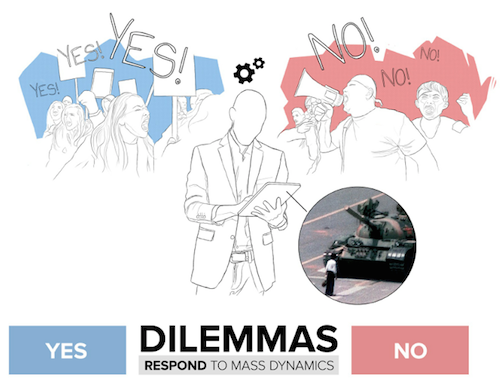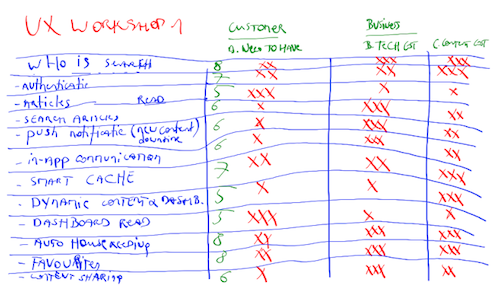How To Streamline Creative Dialogue
In the beginning of my professional career, I often struggled with status meetings. They regularly turned into back-and-forth conversation with a client who was making weird design suggestions. I often left these meetings feeling very confused, uncertain and demotivated after weeks of passionate effort.
It took me a while to figure out what was happening and how I could improve my workflow. With this article, I want to share my learnings after years of streamlining creative dialogue.

A Clear Understanding
Looking back at these confusing meetings, I noticed that we often discussed visual or technical issues without a clear understanding of the business goals — sometimes even without clear objectives at all! Instead of identifying the true problems and expectations, we immediately jumped to design suggestions that were based on personal opinion, assumption and gut feeling.
One of the most important improvements I made was introducing a learning phase in every new project we did. Its purpose is to make sure the entire team has a clear understanding of the problem(s) we are going to address, both for the business and the user. We approach this simply by asking the right questions and listening carefully. Here are a few of my favorite questions, which I’ll fire off during a strategic workshop with a client or while interviewing current or potential customers.
- Why would you recommend this product to a friend?
- What problems do you see that really concern you?
- What’s the first change you want to see?
- Why is this project or product so important for the company?
- What story about this project would you like to read in the newspaper?
- What would be the biggest compliment a customer could give your organization?
"If I had an hour to solve a problem, I’d spend 55 minutes thinking about the problem and 5 minutes thinking about solutions." * Albert Einstein
Running Interviews
Running interviews shouldn’t be complex. It’s all about facilitating the conversation and helping to detect the real needs, problems or expectations. Start the interview by asking some of the questions above, and let others do the talking at first. Here are a few guidelines we use to process the answers and turn them into valuable learnings and observations.
- Keep it simple. Ask only one question at a time, and always focus on the person being interviewed. The question itself should be as simple and direct as possible, without any assumption or hidden opinion.
- Give them a second. Simple questions are often not so simple to answer. Give people some time and space to think and formulate their thoughts. A few seconds of silence does not have to be awkward!
- Remove contextual information. Prepare for long answers that provide all sorts of explanations. Try to summarize and fine-tune these answers by removing the contextual information. Only when no context is required will an answer truly be crystal clear. You can aim for this by asking more questions and diving deeper into the subject. Repeat the core of what they are saying — according to you, that is — and ask if you’ve understood correctly.
- Aim for the one-minute answer. Coach people towards an answer that can be given in less than one minute. This little trick also helps to remove irrelevant context and keep answers short and easy to understand.
- Record the interview. I have found that recording interviews on video is a great way to easily capture and share the output. You can even produce a short documentary to distribute internally. Works like a charm!
A Real-Life Example
Here is an example of conversation between me and a client during our first workshop. We had just partnered up to build a communication platform promoting metal packaging. I wanted to find out why the organization promotes metal and how the platform could boost their objectives.
Me: What problems do you see that really concern you? Client: People don’t know that metal is the only material that can be recycled forever. Once recycled, it is still as powerful and strong as before, while materials like plastic and tetra lose their strength! We all think that recycling our products contributes to an environmentally friendly supply chain, but only metal can be reused forever. Other materials might recycle a few times, but eventually they just die — not really that environmentally friendly because new material is required very soon! Me: So, what is it exactly that you want to do about this? Client: We need to inform people about the benefits of metal so that we can help grow metal packaging. Me: And why is this so important to you? Client: Because we need to convince brands to package their products in metal! Me: How could we solve this problem? Client: We asked you to help us build a communication platform to inform and educate people. Isn’t that obvious? Me: Almost! What does the platform need to do? Client: It should help us explain the benefits of metal! Me: Not exactly. It seems to me that the goal is also to convince decision-makers to try out metal.Client: Exactly! Me: So, would you agree that the platform we are building should not just inform and educate people, but convince decision-makers as well? Client: Of course, it should.Me: I’ve just learned that the platform should not just focus on the benefits of metal, but also on the benefits for decision-makers.Client: Yes, I believe so.Me: Let’s find out how to catch their attention, then.
Simply by asking the right questions and diving deeper into the subject, we all learned that the original briefing was not perfect. The client requested a communication platform to promote the benefits of metal. They never mentioned that it should also promote the benefits to decision-makers. This 15-minute conversation really made all the difference.
Learnings And Observations
To wrap up the conclusions of our learning phase, we deliver a learnings and observations presentation. This deliverable summarizes the bigger picture and provides a validated overview of important goals and expectations. Our learning phase has always led to new insights and revealed misunderstandings. Redesigning the briefing has been a must ever since!
Teamwork Wins Championships
Like many other design teams, we were used to working out ideas on our own. We typically met with the client once a week to discuss progress and feedback. During these status meetings, we gained new creative insights, and sometimes we even experienced misunderstanding about a certain objective. And what did we do? We locked ourselves up for another week and iterated on what we had designed — on our own, without direct interaction with the client, stakeholder or customers.
After a while, I realized that this was extremely silly and inefficient. Great work happens when everybody is involved in the creative process. That’s why I decided to include at least two design workshops with the entire core team and customers. Sometimes we even run full-week sprints! During these workshops, we work on the most important business objectives and encourage everybody to participate in the ideation and design process.

Preparing and facilitating these workshops properly is really important. I’ll ask the client to prepare a presentation on tools, products and competitors that inspire them. It shows us what types of discussions they’ve already had and which creative directions they like. Next on my list is to define the true goals, problems and opportunities from a business perspective and to understand the user’s needs, fears and expectations. Many teams struggle with defining this and will need your help. A great tool to facilitate this is the Value Proposition Canvas.
I always try to have a core group of six to eight people working together full time. The most important roles are the ones for process facilitation, product design, technology and business strategy. We also invite users for feedback sessions once or twice. It’s amazing to see visual thinkers, technical realists, strategic decision-makers and customers influence and inspire each other directly. Facilitating this kind of collaborative design is one of the most rewarding decisions I’ve made. Let me walk you through some of our best practices to get you started.
The Right Environment
To get clients out of their daily routine, we often invite them to our studio for workshops. This works great for half a day; running multiple days might be difficult to facilitate. When we look for a great workshop environment, we always take a few things into account.
The location should be big enough for the entire group. Don’t lock the team up in a tiny room; people needs space and air. Make sure that everybody is able to sit together at a central open desk, and reserve a second room for private conversations.
We also provide breakfast, coffee, lunch and snacks. People immediately feel more relaxed when they see you’ve taken care of everything. Not having to think about food and drinks also stimulates concentration during the workshop.

Stand Up, Speak Up
Start every part of the workshop by running a standup meeting, and explain which particular objective the group is going to address next. Encourage each team member to share their individual thoughts publicly. Taking a minute to truly hear what others are thinking is very inspiring and leads to more constructive conversations.
Here is an example of a conversation from a standup meeting that we had with a client who runs a Holocaust museum. We were in the process of designing a mobile app to boost the visitor’s experience.
Me: Welcome back, everybody. Yesterday we matched the guided tour with the overall objectives of the museum. We learned that while the Holocaust story leaves a deep impression, we want to draw more attention to the underlying conditions that lead to human rights violation today. For the next two hours we are going to explore how the mobile app can help us raise more awareness. I’d like to ask everyone where or when during the tour you believe the Museum does a good job of raising awareness.CEO: When a group of people walk towards the first floor, they pass a picture of thousands of people dancing at a festival. They are surprised that this is the first thing they see in a Holocaust museum. This picture shows the energy of mass dynamics, where one DJ is steering a bunch of people. This is an important underlying condition, and I believe the picture works pretty good.Holocaust Expert: When people are on the third floor, they see some advertising posters from the early ’40s, informing people that Jews are no longer allowed to listen to the radio. This direct communication leaves a deep impression, a very powerful piece of the tour in my opinion.Museum Guide: I actually agree with our CEO. That picture is very powerful.Designer: I found the advertising posters very impressive as well. I actually wonder how it would look like in today’s digital advertising channels like Facebook or YouTube.Developer: I agree with the examples mentioned already. Oh, and I wonder if the government would actually manipulate my Facebook stream.Me: Thanks, everybody. Let’s explore this further from a mobile app perspective.
During this standup meeting, we created a positive atmosphere for the next brainstorming session. My team understood which stories already perform great, and the client found out that Facebook could actually be manipulated. You would be surprised by how many people still think their stream is a chronological overview of items!
Encourage Visual Communication
I always encourage visual communication. Having something tangible to talk about leads to better understanding and stimulates constructive feedback and improvement. Sketching strategic diagrams, drawing mind maps and illustrating UI concepts via pen and paper — no matter what topic is being discussed, I ask people to work out visuals instead of words and present them to each other. I’ve learned that a group of people need to see what you mean in order to better understand your point of view.


Facilitate Ideation
To facilitate idea generation between teams and stimulate discussion and feedback, we follow three important rules:
- An idea starts with introducing a problem or an opportunity to tackle it.
- An idea is explained by walking everybody through a visual output that describes a conceptual user scenario.
- An idea is wrapped up by illustrating how both the business and the user would benefit from the idea.
Here is an example of an idea (labelled “Idea 6, Tankman”) that was presented during one of the brainstorming sessions we did with the Holocaust Museum team:
- The problem. This idea addresses our desire to introduce two underlying conditions: the bystander effect and the perpetrator effect.
- The user experience. Once a user arrives at the Tiananmen Square photograph, located on the second floor, the app automatically presents a dilemma:
- Drive over the person.
- Don’t drive over the person.No matter which choice the user makes, suddenly they will hear the driver’s protest. Here are some possible scenarios:
- Drive over the person? No, we can’t do this! He’s a human being!
- If we don’t drive over this person, we will be killed ourselves!
- The benefits. By creating an emotional audiovisual interaction, we think users will have a better understanding of the bystander and perpetrator effect. And that’s exactly what we want to achieve.

The Validation Matrix
One thing you have to know is that everyone loves their idea the best. To stay away from ego-driven prioritization and to help us validate creative output, we define official evaluation parameters.
Make sure that your parameters are based on business objectives and practical matters, instead of assumption, opinion or gut feeling. Usually we end up with three to seven specific parameters. Here are a few classics:
- Do we believe this can solve one of our main problems?
- Do we believe users really need this?
- Will building this properly take a lot of time and energy?
- Will maintaining it take a lot of time and energy?
- Do we believe users will experience something outstanding?
Ask every team member to rate every parameter for every idea. Keep it simple and use a one to three star rating system. If a team member believes that an idea serves a parameter well, they are allowed to give three stars. If they believe it doesn’t serve well, they would give only one star. If they think it’s somewhere in the middle, they would give two stars.
Simply by adding all of the scores for every idea, based on the parameter stars, you can quickly validate how much an idea actually contributes to the briefing. Below is an example; as you can see, it is very hands-on.

This validation matrix is a great technique to wrap up an ideation phase. After involved collaboration, the entire team receives a prioritized overview of ideas, together with the visual communication created during the workshop.
As of this very moment, we’ve evolved into a relationship where everybody truly understands both the strategic and creative direction that we need to take. On top of that, people have actually gotten to know each other on a more personal level. They’ve shared laughs and frustrations, and they’ve worked together in pursuit of the best result. This is a very valuable experience that would be hard to achieve any other way.
Go Get ’Em!
Every project starts with a briefing sent to your team. Don’t take the content for granted, and make sure you clearly understand the objectives before working out anything tangible. You can do this by including a small learning phase, based on interviews with your client and their customers. I promise you that by simply asking the right questions, you’ll learn a hell of a lot more.
Address your learnings and observations in an involved relationship. Encourage clients to get on board during these creative workshops, even if they consider themselves to be “uncreative.” Create an environment that allows them to collaborate and to visually discuss creative output.
By streamlining this kind of creative dialogue, I’ve moved away from confusing meetings and inefficient design efforts and toward constructive client interaction and spot-on projects with a great impact on business and customers. I hope this article helps you to do the same!
I’m looking forward to reading your thoughts and comments. Feel free to share them!
Further Reading
- Effectively Planning UX Design Projects
- Stop Writing Project Proposals
- How To Convince The Client That Your Design Is Perfect
- Meeting Your Client for the First Time




 Register!
Register! Flexible CMS. Headless & API 1st
Flexible CMS. Headless & API 1st



